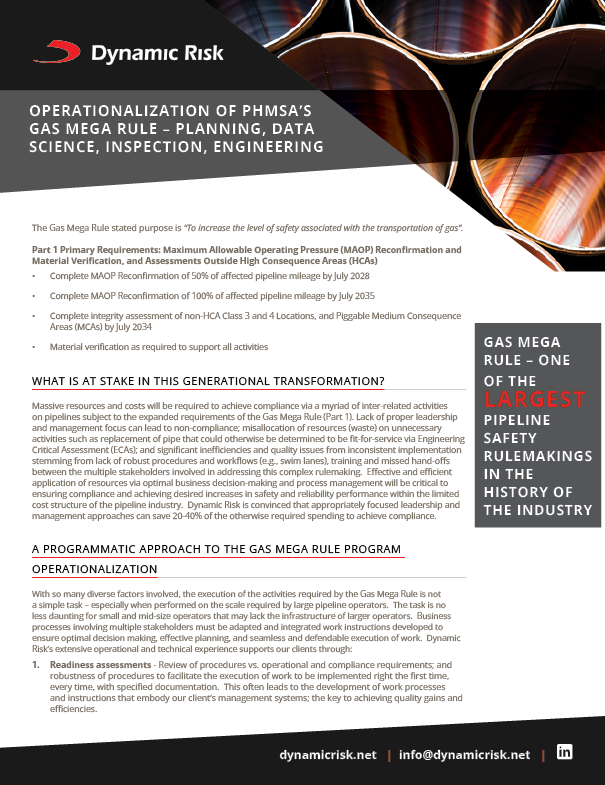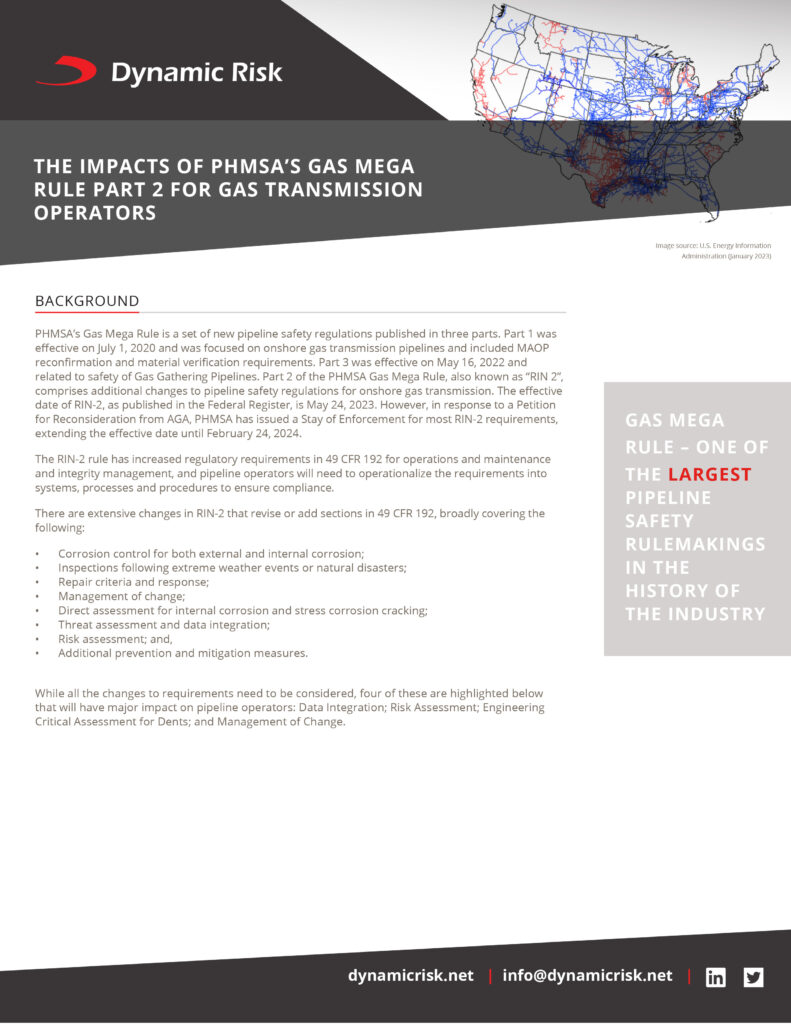About The PHMSA Gas Mega Rule
The Gas Mega Rule stated purpose is “To increase the level of safety associated with the transportation of gas”.
The Pipeline and Hazardous Materials Safety Administration (PHMSA) has implemented a regulatory framework commonly referred to as the “Gas Mega Rule.” Officially enacted on July 1st, 2020, the Gas Mega Rule has prompted gas transmission operators to meticulously assess their rule readiness and undertake preparatory measures to navigate the potential impacts on their integrity management programs and operating practices. This requires operators to effectively address the following key activities:
- Expand Integrity Management requirements beyond High Consequence Areas (HCAs) to Moderate Consequence Areas (MCAs)
- Require pipeline operators to verify records to establish Maximum Allowable Operating Pressure (MAOP)
- Require testing of untested pipe to confirm MAOP
Effective and efficient application of resources via optimal business decision-making and process management will be critical to ensuring compliance and achieving desired increases in safety and reliability performance within the limited cost structure of the pipeline industry.
Leveraging its extensive expertise, Dynamic Risk has put together an assortment of resources for pipeline operators to better understand the PHMSA Gas Mega Rule and its impacts on the pipeline industry.
These resources embody our commitment to fostering a comprehensive understanding of the rule’s intricacies, aiding operators in making informed decisions, and paving the way for an industry-wide pursuit of enhanced safety and operational excellence.
“Gas Mega Rule” Part 1
Part 1 Primary Requirements: Maximum Allowable Operating Pressure (MAOP) Reconfirmation and Material Verification, and Assessments Outside High Consequence Areas (HCAs):
- Complete MAOP Reconfirmation of 50% of affected pipeline mileage by July 2028
- Complete MAOP Reconfirmation of 100% of affected pipeline mileage by July 2035
- Complete integrity assessment of non-HCA Class 3 and 4 Locations, and Piggable Moderate Consequence Areas (MCAs) by July 2034
- Material verification as required to support all activities
The primary requirements of Part 1 of the Gas Mega Rule involve the thorough reconfirmation of the Maximum Allowable Operating Pressure (MAOP) and meticulous material verification, along with assessments extending beyond High Consequence Areas (HCAs):
Comprehensive MAOP Reconfirmation: Pipeline operators are tasked with completing reconfirmation of the MAOP for 50% of the affected pipeline mileage by the deadline of July 2028. In addition, the Mega Rule algo stipulates the completion of MAOP reconfirmation for the entire affected pipeline mileage, covering 100%, by July 2035.
Extensive Integrity Assessments: the Gas Mega Rule also mandates the execution of integrity assessments for non-High Consequence Area (HCA) Class 3 and 4 Locations, as well as Piggable Moderate Consequence Areas (MCAs). These assessments must be concluded by July 2034.
Thorough Material Verification: Part 1 requires meticulous material verification to support all activities related to the rule’s requirements.
Get access to our comprehensive brochure to learn more:
“Operationalization Of PHMSA’s Gas Mega Rule – Planning, Data Science, Inspection, Engineering Brochure”

Explore further insights by checking out our blog post:
The PHMSA Gas “Mega Rule” In Practice
“Gas Mega Rule” Part 2
Part 2 of the PHMSA Gas Mega Rule, also known as “RIN 2”, comprises additional changes to pipeline safety regulations for onshore gas transmission. The RIN-2 rule has increased regulatory requirements in 49 CFR 192 for operations and maintenance and integrity management, and pipeline operators will need to operationalize the requirements into systems, processes and procedures to ensure compliance.
While all the changes to requirements need to be considered, four of these changes will have major impact on pipeline operators: Data Integration; Risk Assessment; Engineering Critical Assessment for Dents; and Management of Change. These alterations require careful consideration and effective implementation to ensure operations align with the updated regulatory landscape.
Delve into Part 2 of the PHMSA Gas Mega Rule:
“Navigating the Impacts of PHMSA’s Gas Mega Rule Part 2 for Gas Transmission Operators.”

Gain deeper understanding by exploring our blog post:
Impacts of PHMSA’s Gas Mega Rule Rin-2 For Gas Transmission Operators
Engineering Critical Assessments (ECA) for MAOP Reconfirmation
The U.S. Pipeline regulatory structure continues to experience significant changes that will facilitate gaining the next level of safety and reliability performance. With the release of Part 1 of the Gas Mega Rule in October of 2019 (effective July 1, 2020), in lieu of replacement or re-testing pipelines, operators have the option of applying Engineering Critical Assessments (ECAs) and advanced fitness-for-service solutions for validating and reconfirming maximum allowable operating pressure (MAOP). The requirements for the ECA are outlined in §192.632.
Reconfirmation of MAOP (MAOP-R) has the potential for billions of dollars of effort/impact if the industry must rely on replacements, pressure reductions, and pressure tests for compliance. ECAs provide an effective performance-based pathway forward to obtain the greatest yield from resources in terms of increasing pipeline safety and reliability and providing maximum return on investment.
Dive into further insights with our white paper:
Our whitepaper encompasses an overview of industry regulations, a technical alignment framework for ECAs, a three-step approach to ECAs, practical application examples, and a value assessment for pipeline operators.

Interested in expanding your knowledge? Discover a wealth of information in our Resource Hub, featuring webinars, presentations, and more whitepapers.
Webinars, Presentations & Whitepapers:
Webinar & Whitepaper: About The PHMSA Gas Mega Rule
Request Access To Webinar Request Access To Whitepaper
Are you Ready? Key Insights of PHMSA’s Gas Mega Rule for Transmission Pipelines
and the impacts on Operations and Maintenance
Partner’s Conference 2021 Presentation

Ben Mittelstadt – Director, Technical Services
In this presentation, Ben explores how efficient and effective processes are necessary to implement and address these requirements, how access to data underpins them all, and how novel approaches through data sharing and data science support the development of industry leading solutions.
Request Access To Presentation
More PHMSA Gas Mega Rule Industry Blogs
Pipeline industry subject matter experts at Dynamic Risk have curated a list of important blog topics on the PHMSA Gas Mega Rule to help operators better understand the impacts to the industry and how to best manage their pipeline assets moving forward:


